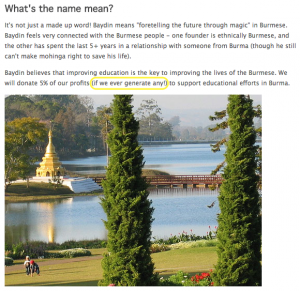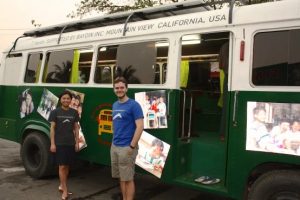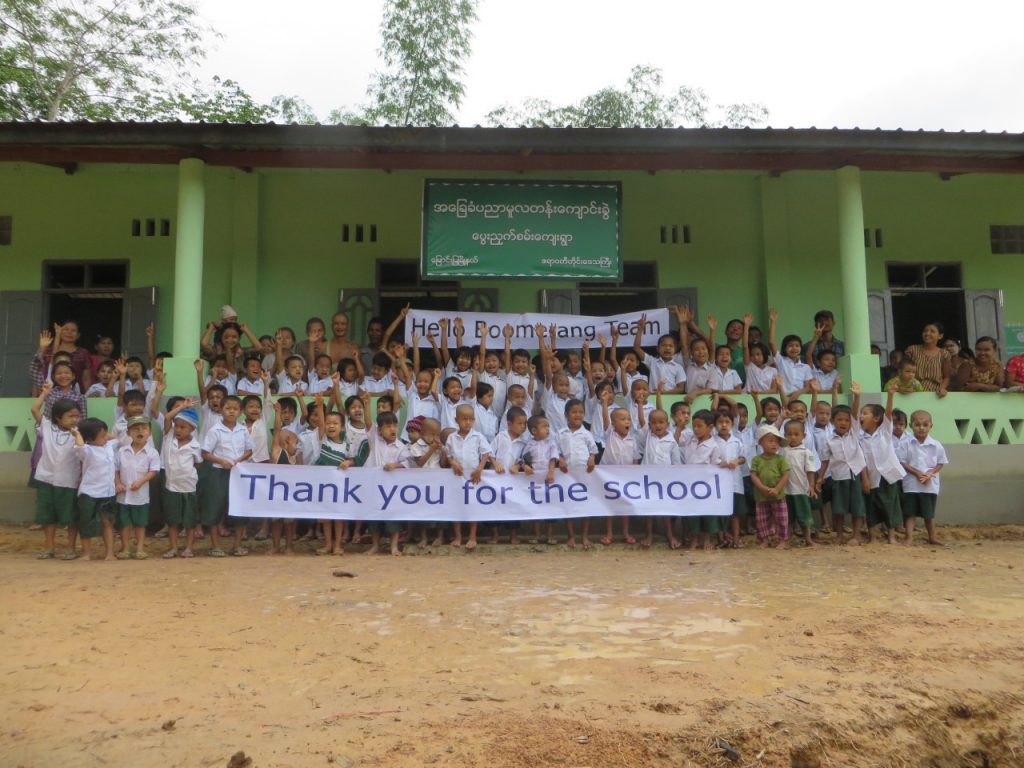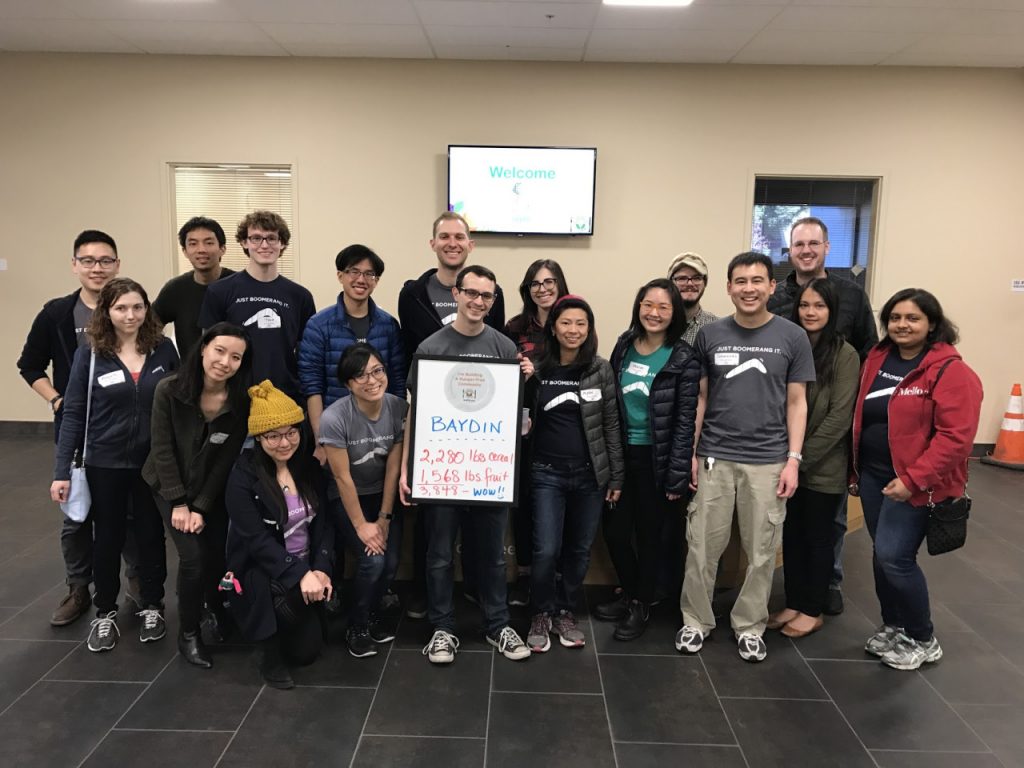 Years ago, when Boomerang went by Baydin, we committed to donate a portion of our profits to educational efforts in Burma (with the disclaimer “if we ever generate any!”) So when profitability stopped being a hypothetical in 2013, we made our first donation to build a mobile classroom for children working in Burmese tea shops (more on that later!) Since then, Boomerang has grown, as have our donations.
Years ago, when Boomerang went by Baydin, we committed to donate a portion of our profits to educational efforts in Burma (with the disclaimer “if we ever generate any!”) So when profitability stopped being a hypothetical in 2013, we made our first donation to build a mobile classroom for children working in Burmese tea shops (more on that later!) Since then, Boomerang has grown, as have our donations.
Giving back is an important part of our company culture, so we wanted to share how we make donations, as well as what our donations accomplish (our latest effort built a village in Burma its first school!)
How We Make Donations
We pride ourselves on being thoughtful and focused on the process at Boomerang (in fact, those are two of our company values.) So when we make donations, it’s more than writing a check to any organization involved with education in Burma. We seek out partners with projects that have a direct and sustained impact on a community with a documented need.
Our donations typically go to smaller organizations that are scrappy, fast-moving, and can quickly respond to the needs of the community. While there is plenty of good work done by charities and NGOs on large-scale issues like improving education systems country-wide, we prefer to work with organizations that focus on smaller projects where we can more quickly, easily, and confidently see results from our contributions.
We also seek out partners that emphasize sustainability, as there’s fleeting value in building a school if you can’t be sure it will be staffed with teachers in a couple years. We donate to organizations that are not only knowledgeable about a community and the Burmese government, but that are actively engaged with them. Projects should not only meet the immediate needs of a community, they should entail a long-term commitment from stakeholders (such as those in government) and benefit a community in perpetuity.
Boomerang’s Philanthropy in Action
 2013-2014: Myanmar Mobile Education Project
2013-2014: Myanmar Mobile Education Project
Our first donation in 2013 went to the Myanmar Mobile Education Project (myME) to help build a mobile (bus) classroom that served children who worked in tea shops in Burma. This project hit all the points emphasized above: it was a scrappy, smaller organization (it funded its first bus via Indiegogo) that was addressing a clear, specific need (education for children working in tea shops) in a sustainable way by involving necessary stakeholders (myME got long-term commitment from tea shop owners to allow their child-workers to participate, and hired only local teachers.) myME started with one bus and 60 students, but they now have a caravan of buses (one with our name on it!) and over 1,200 students.
2014: Phandeeyar – Myanmar Innovation Lab
At the end of 2014, we donated to Phandeeyar, a technology innovation hub based in Yangon (Rangoon.) Phandeeyar teaches its participants skills that are pretty universal, such as how to program, how to approach entrepreneurship, and how to start a business. But it also plays an important role in covering civil society topics unique to Burma. Freedom of the press, open internet access, and connections to the outside world are something that have historically been limited in Burma by the military junta government that ruled until 2011.
By going beyond teaching technical topics, Phandeeyar better prepares its participants for a world with open access to information and readies them for the global marketplace.
2015-Present: Build a School in Burma
We’ve most recently teamed up with another non-profit focused on education in Burma. It was started in the Bay Area by former Peace Corps volunteers and has a name that aptly describes its focus: Build a School in Burma.
Build a School in Burma (BSB) started off with a very specific focus: building one school. They turned out to be pretty good at it, and now have over a dozen schools under their belt. We were drawn by their approach that engages local communities and the Burmese government, and prioritizes towns that will benefit most. Among the criteria they use for deciding where to build schools are:
- How many school-aged children are in the town?
- BSB builds schools in the areas with the most need.
- Is there support from the local community?
- Some towns will gift a free plot of land, so BSB does not have to purchase it.
- Will the government provide staff for the schools?
- BSB builds schools where the Ministry of Education has no plans to construct schools itself but is willing to staff teachers.
- Are there other benefits for constructing a permanent building in the town?
- Schools can often double as a shelter when cyclones and other disasters hit.
But what impressed us most was Build a School in Burma’s speed. In December 2015, BSB found a village located six hours away from Yangon where our donation could build a school. Just months later, a brand new school was constructed, and it was open for classes by June. And while we were confident our donation would make a difference, its impact has already exceeded our expectations.

Before the school was built, BSB expected that 80 students would attend based on their discussions with the village. The school opened in June with a capacity of 100 students, but this has already been exceeded! The school not only improves the education of villagers, it also makes them safer. Previously, students would walk to a neighboring village to attend school, but this was only possible for part of the year. Each monsoon season, the bridge that led to the nearby village got washed away, which made getting to school dangerous (a child died from floods just a few years ago) and often impossible for months at a time.
We’re thrilled to have found a partner like BSB that allows us to quickly and effectively improve the education and safety for the children. With the completion of the school, we were left with only one question: what’s next?
A Continued Effort
Boomerang continues to look for more ways to give back, and not just to organizations involved with education in Burma. We’ve also made donations to open source initiatives, including the communities behind tools that have made Boomerang possible. Hands-on service events are also a tradition: we’ve taken afternoons off as an office for activities like sorting fruit or cereal at a local food bank.
Want to hear more about what Boomerang is up to? Subscribe to our email list.
We’re excited to be in a position where we can give back, and we have no plans on stopping!

